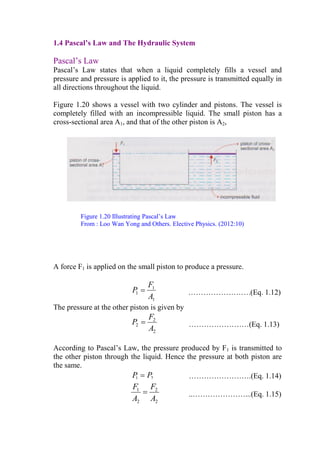
Pascal's Law and Hydraulic Systems Explained
- 1. 1.4 Pascal’s Law and The Hydraulic System Pascal’s Law Pascal’s Law states that when a liquid completely fills a vessel and pressure and pressure is applied to it, the pressure is transmitted equally in all directions throughout the liquid. Figure 1.20 shows a vessel with two cylinder and pistons. The vessel is completely filled with an incompressible liquid. The small piston has a cross-sectional area A1, and that of the other piston is A2, Figure 1.20 Illustrating Pascal’s Law From : Loo Wan Yong and Others. Elective Physics. (2012:10) A force F1 is applied on the small piston to produce a pressure. 1 1 1 A F P = …………………….(Eq. 1.12) The pressure at the other piston is given by 2 2 2 A F P = ……………………(Eq. 1.13) According to Pascal’s Law, the pressure produced by F1 is transmitted to the other piston through the liquid. Hence the pressure at both piston are the same. 21 PP = …………………….(Eq. 1.14) ..…………………...(Eq. 1.15) 2 2 2 1 A F A F =
- 2. 23 Hydraulic System Hydraulic Systems work by using liquids under pressure. They make use of two properties of liquid. : Liquid are incompressible, : If pressure is applied to an enclosed liquid, the pressure is transmitted to all parts of the liquid. Figure 1.21 show how a simple hydraulic press works. A small force applied to the small piston can lift a greater load on the large piston. The input pressure P1, supplied by an input force F1 on a small piston area A1 is transmitted to the large piston, which has a area A2. Since 21 PP = , where P2 is the output Pressure, 2 2 1 1 A F A F = = 1 2 12 A A FF …………….(Eq. 1.16) Since A2 > A1, it follows that F2 > F1. The snag in hydraulic press is that we need to push the smaller piston through a long distance d1 in order for the bigger piston to move through a small distance d2, This is due to the fact that the volume of liquid pushed by the smaller piston V1 is equal to the volume of liquid that goes below the bigger piston V2. Figure 1.21 Hydraulic press. From : Loo Wan Yong and Others. Elective Physics. (2012:11).
- 3. 24 12 VV = ……………..……...(Eq. 1.17) 1122 dAdA = …………………….(Eq. 1.18) = 2 1 12 A A dd …………………….(Eq. 1.19) Since A2 > A1, it follows that d2 < d1. Example 1.10 Figure 1.21 shows a simplified form of a hydraulic press. A force of 50N is applied to the smaller piston of 0.01 m2 . (a) The large piston has an area of 0.20 m2 . Calculated (i) the pressure exerted on the liquid by the smaller piston, Figure 1.22 Example 1.10 the pressure exerted on From: Loo Wan Yong and Others. (ii) the large piston, Elective Physics. (2012:11). (iii) the load that can be lifted. (b) If the smaller piston is pushed down through a distance of 10 cm, how much will the large piston move up? Solution : (a) (i) Pressure A F P = 2 01.0 50 m N = Pa5000= (ii) This pressure is transmitted in the liquid and is the same everywhere within the liquid. Thus the pressure under the bigger piston must also be 5000Pa (iii) The bigger piston has an area of 0.20 m2 . The load that it can support is given by PAF = 2 02.05000 mPax= N1000=
- 4. 25 (b) The volume of liquid that moves out from the smaller cylinder equals the volume of liquid that moves into the bigger cylinder. 12 VV = cmxmxdm 1001.020.0 2 2 2 = = 2 2 2 20.0 1001.0 m cmxm d cm50.0= Example 1.11 Figure 1.23 the car has 1,000 kg. on the right of hydraulic, an diameter 14 cm. Area of the small hydraulic has diameter 7 cm. Calculate the force to move up the car. Figure 1.23 Example 1.11 From: Loo Wan Yong and Others. Elective Physics. (2012:11). Solution : Find area smaller piston 21 1 ) 2 ( d A π= 2 2 1 ) 2 107 ( − = x A π ) 4 107 ( 4 1 − = x A π Find area bigger piston 22 2 ) 2 ( d A π= 2 2 2 ) 2 1014 ( − = x A π ) 4 10196 ( 4 2 − = x A π
- 5. 26 From 2 2 1 1 A F A F = ; Force to lift mgF =2 21 1 A mg A F = 2 1 1 A mgA F = π π ) 4 10196 ( ) 4 107 )(/101000( 4 4 2 1 − − = x x smkgx F N14.357=
- 6. 27 Problem 1.4 Hydraulic System 1. The diagram on above shows a simple hydraulic jack. Assuming that the jack is frictionless: a) What is the pressure at A? ……………………………………………………………….. …………………………………………………………………… …………………………………………………………………… …………………………………………………………………… b) What is the output force? ………………………………….………………………………… ………………………………….………………………………… ………………………………….………………………………… ………………………………….………………………………… c) What is the pressure at B? …………………….………………………………… ………………………………….………………………………… ………………………………….………………………………… ………………………………….………………………………… 2. In the jack on the above, what would be the effect of: a) increase the area of the output piston? ………………………………………………………….. ………………………………………………………….. b) decrease the area of the input piston? ………………………………………………………….. ………… ……………………………………………….. …………………………………………………………..
